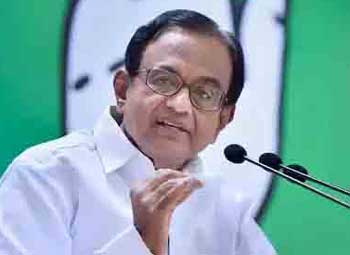New Delhi, October 19, 2025 – Senior Congress leader P. Chidambaram has sounded the alarm over India’s slowing economic growth, describing the current 6.5% GDP growth rate as indicative of the nation being trapped in a lower-middle-income bracket. Speaking at a press conference in New Delhi, Chidambaram urged the government to implement bold, transformative economic reforms similar to those undertaken by former Prime Minister Manmohan Singh in the early 1990s.
Chidambaram said:
“India cannot afford complacency. A 6.5% growth rate may look decent on paper, but it masks structural weaknesses. Without decisive reforms, we risk stagnation and falling behind other emerging economies.”
Economic Concerns Highlighted
Chidambaram highlighted multiple areas of concern:
Investment Slowdown: Foreign direct investment (FDI) inflows have slowed compared to projections.
Employment Challenges: Job creation remains insufficient to absorb a growing workforce.
Inflation and Cost of Living: Rising consumer prices are impacting household budgets and savings.
Sectoral Growth Disparities: Manufacturing and export sectors are underperforming relative to service industries.
He emphasized that India’s economic trajectory is at a critical crossroads, requiring policy interventions that promote sustainable growth, equitable income distribution, and investment in infrastructure.
Calls for Manmohan Singh-Style Reforms
Chidambaram referenced the 1991 economic liberalization reforms under then-Finance Minister Manmohan Singh as a blueprint for transformative change. He urged the current government to consider similar measures, including:
Structural reforms to enhance ease of doing business
Tax rationalization to support small and medium enterprises (SMEs)
Promoting export-led growth and reducing trade deficits
Strengthening financial inclusion and digital banking infrastructure
“We need courage to implement reforms that may be politically challenging but are necessary for long-term growth,” Chidambaram stressed.
Political Reactions and Expert Opinions
Chidambaram’s comments have sparked discussion across political and economic circles. Analysts note that his critique signals the Congress party’s push to hold the government accountable on economic performance ahead of upcoming elections.
Economist Dr. Anjali Menon remarked:
“Chidambaram is right to focus on structural reform. India’s growth rate is decent compared to some neighbors, but the quality of growth—job creation, equitable development, and investment—is what matters.”
Several opposition leaders echoed his concerns, highlighting the need for policy transparency and long-term economic planning.
Implications for India’s Economy
The critique comes at a time when India is navigating complex global economic pressures:
Global Inflationary Trends: Rising energy prices and supply chain disruptions.
Geopolitical Uncertainty: International conflicts affecting trade and investment.
Domestic Challenges: Urban-rural growth disparity and income inequality.
Chidambaram stressed that addressing these challenges requires strategic policymaking, not just incremental economic measures.
Public and Media Reaction
Social media platforms and news channels have widely covered Chidambaram’s statements. Citizens expressed mixed reactions, with some praising his call for reform and others debating the feasibility of implementing such measures in the current political climate.
Twitter user @EconomyWatcher wrote:
“Chidambaram is right—6.5% growth doesn’t tell the full story. India needs jobs and fair wealth distribution, not just numbers on GDP charts.”
Conclusion
Senior Congress leader P. Chidambaram’s critique of India’s 6.5% growth rate underscores the need for bold, decisive economic reforms. Drawing on lessons from Manmohan Singh’s transformative policies, Chidambaram emphasized the importance of addressing structural weaknesses, promoting job creation, and ensuring equitable growth.
As India faces domestic and global economic challenges, policymakers are under pressure to adopt forward-looking reforms that not only improve GDP figures but also enhance quality of life, employment opportunities, and investor confidence.
The coming months are likely to see intense political and economic debates as India seeks solutions to maintain its trajectory as one of the fastest-growing major economies in the world.
















